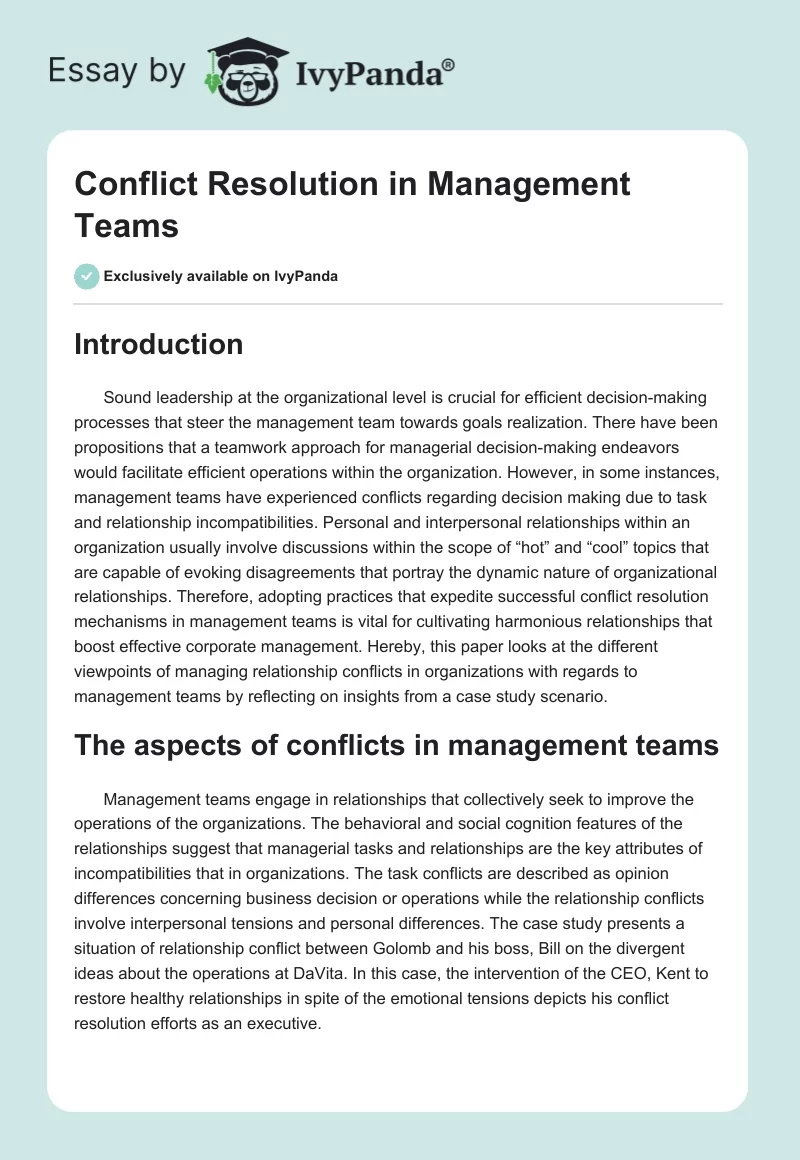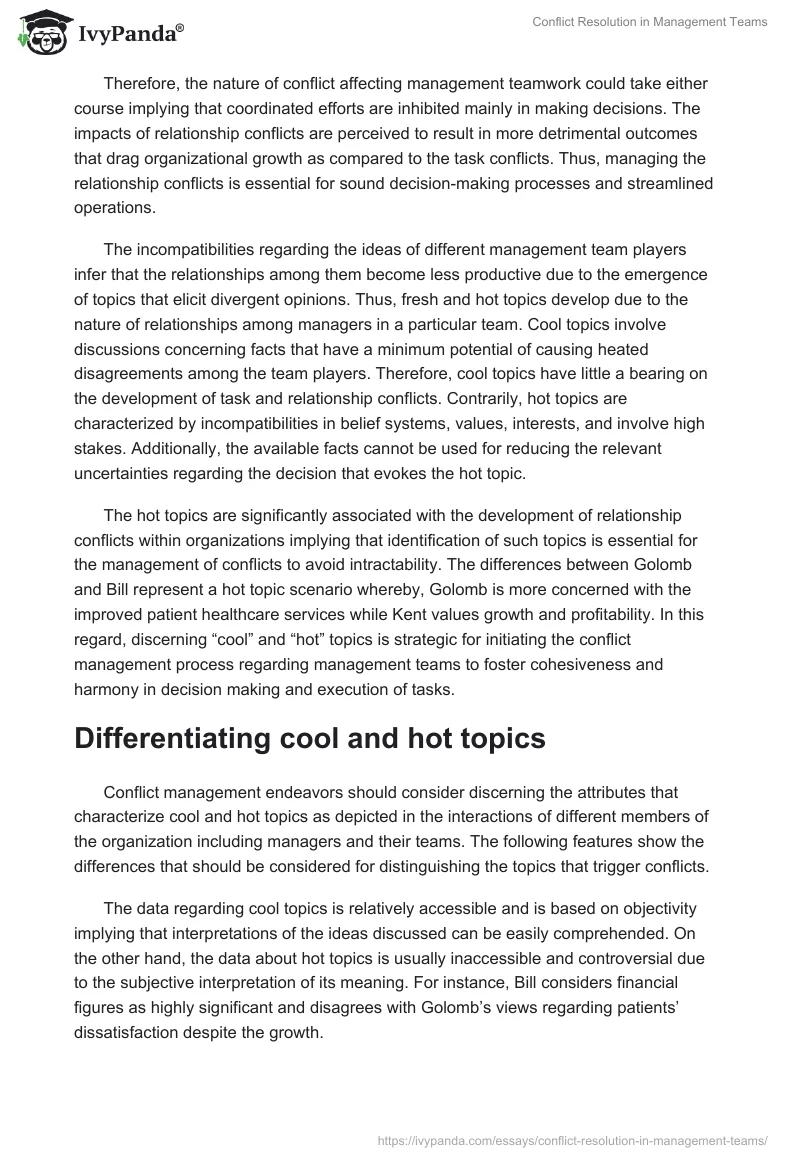Introduction
Sound leadership at the organizational level is crucial for efficient decision-making processes that steer the management team towards goals realization. There have been propositions that a teamwork approach for managerial decision-making endeavors would facilitate efficient operations within the organization. However, in some instances, management teams have experienced conflicts regarding decision making due to task and relationship incompatibilities.
Personal and interpersonal relationships within an organization usually involve discussions within the scope of “hot” and “cool” topics that are capable of evoking disagreements that portray the dynamic nature of organizational relationships. Therefore, adopting practices that expedite successful conflict resolution mechanisms in management teams is vital for cultivating harmonious relationships that boost effective corporate management. Hereby, this paper looks at the different viewpoints of managing relationship conflicts in organizations with regards to management teams by reflecting on insights from a case study scenario.
The aspects of conflicts in management teams
Management teams engage in relationships that collectively seek to improve the operations of the organizations. The behavioral and social cognition features of the relationships suggest that managerial tasks and relationships are the key attributes of incompatibilities that in organizations. The task conflicts are described as opinion differences concerning business decision or operations while the relationship conflicts involve interpersonal tensions and personal differences.
The case study presents a situation of relationship conflict between Golomb and his boss, Bill on the divergent ideas about the operations at DaVita. In this case, the intervention of the CEO, Kent to restore healthy relationships in spite of the emotional tensions depicts his conflict resolution efforts as an executive.
Therefore, the nature of conflict affecting management teamwork could take either course implying that coordinated efforts are inhibited mainly in making decisions. The impacts of relationship conflicts are perceived to result in more detrimental outcomes that drag organizational growth as compared to the task conflicts. Thus, managing the relationship conflicts is essential for sound decision-making processes and streamlined operations.
The incompatibilities regarding the ideas of different management team players infer that the relationships among them become less productive due to the emergence of topics that elicit divergent opinions. Thus, fresh and hot topics develop due to the nature of relationships among managers in a particular team. Cool topics involve discussions concerning facts that have a minimum potential of causing heated disagreements among the team players.
Therefore, cool topics have little a bearing on the development of task and relationship conflicts. Contrarily, hot topics are characterized by incompatibilities in belief systems, values, interests, and involve high stakes. Additionally, the available facts cannot be used for reducing the relevant uncertainties regarding the decision that evokes the hot topic.
The hot topics are significantly associated with the development of relationship conflicts within organizations implying that identification of such topics is essential for the management of conflicts to avoid intractability. The differences between Golomb and Bill represent a hot topic scenario whereby, Golomb is more concerned with the improved patient healthcare services while Kent values growth and profitability. In this regard, discerning “cool” and “hot” topics is strategic for initiating the conflict management process regarding management teams to foster cohesiveness and harmony in decision making and execution of tasks.
Differentiating cool and hot topics
Conflict management endeavors should consider discerning the attributes that characterize cool and hot topics as depicted in the interactions of different members of the organization including managers and their teams. The following features show the differences that should be considered for distinguishing the topics that trigger conflicts.
The data regarding cool topics is relatively accessible and is based on objectivity implying that interpretations of the ideas discussed can be easily comprehended. On the other hand, the data about hot topics is usually inaccessible and controversial due to the subjective interpretation of its meaning. For instance, Bill considers financial figures as highly significant and disagrees with Golomb’s views regarding patients’ dissatisfaction despite the growth.
Further, the level of certainty pertaining cool topics is typically high whereas in hot topics; the certainty levels range from moderate to low due to the nature of the heated discussions. Conversely, cool topics involve low to moderate stakes compared to the hot topics that are associated with high risks. Bill views budgetary allocations for improving internal processes as an inhibitor of DaVita’s growth and profitability, thus risking its sustainability.
Cool topics depict broadly shared goals while hot topics portray divergent goals due to the deeply held values, interests, and beliefs. Furthermore, the cool discussions are factual and involve rationality whereas the heated discussions involve emotions regarding facts that usually results in personal attacks. The personal attacks directed at Golomb imply that Bill is emotionally overwhelmed by the profitability motives at the expense of compromising the quality of healthcare services as seen at the Dallas unit.
Practices that foster successful resolution of conflicts in management teams
The resolution of conflicts within managerial teams should observe several practices that ensure productive and harmonious relationships. Despite the occasional emotional intensities that face management teams, the embracement of practices that facilitate management of self, conversations, and relationships is necessary. The practices develop skills that facilitate wise well-timed decisions when conflicts emerge.
The practice of self-management involves the ability to assess and transform the feelings and thoughts that inhibit one’s ability to handle issues rationally and calmly during conflicts. Therefore, managers ought to reflect on the responses and reframe the situation when hot topics develop to facilitate the management of their emotions by considering alternate interpretations; thus, act as cooling systems.
Therefore, managers transform their reactions into reflection objects thereby, shifting from the “go” scheme to the “know’ system resulting to cooling down of the situation. Reframing involves discussing the different interpretations of the ideas to identify what the other is missing so as to learn the basis of their differences. Golomb manages self by reflecting on his motives and reframing the situation to capture what Bill was missing; accordingly, he continues emphasizing the importance of valuing the patients’ experiences.
Managing conversations is another essential practice that could be adopted by managers whereby the emotionally heated topics can be harnessed to foster efficient decisions and improve relationships. Thus, managers can curb the eruption of relationship conflicts by digging into the divisible topics and examining the logic that triggers the divergent views. The conversation involving Kent, Bill, and Golomb was meant at improving the relationships between the disagreeing individuals whereby the logic behind the differences was brought to light.
The management of relationships is also vital for the efficient resolution of conflicts within management teams. The practice should consider the development of grounded trust, investment in meaningful relationships, and creating members’ ability to analyze, map, and adjust the pattern of interactions. Golomb manages his relationship with Bill by convincing him that efficient internal processes were equally important as the growth of Davita; hence, he tries to build the trust in their relationship.
Conclusion
Management teams’ conflicts ought to be addressed in a manner that curbs intractability of the incompatibilities. The relationship conflict between Golomb and Bill depicts a scenario of a hot topic that elicits personal differences that could hinder the realization of Davita’s goals. Therefore, the adoption of practices that foster the management of self, conversations, and relationships would have played a central role in managing conflicts at Davita resulting in improved healthcare services and profitability.


